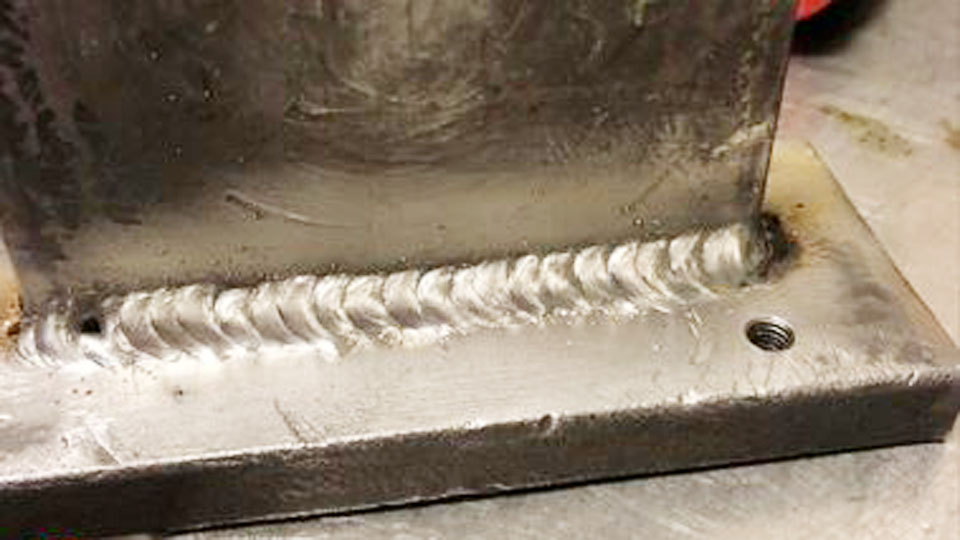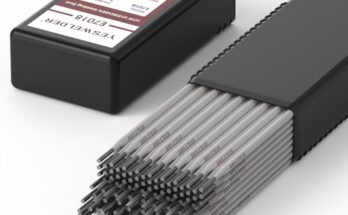Welding stainless steel with Pulse MIG (Metal Inert Gas) welding is one of the best ways to get clean, strong welds with minimal heat distortion.
If you’ve ever struggled with excessive spatter, burn-through, or warping while welding stainless steel, switching to Pulse MIG welding can be a game changer.

Photos by reddit
I’ve spent a lot of time working with stainless steel, and getting the right settings is key to making smooth, high-quality welds. If your settings are off, you’ll run into issues like poor penetration, excessive heat input, or weak welds.
Let’s go through everything you need to know about Pulse MIG welding stainless steel settings to help you get the best results.
What is Pulse MIG Welding?
Pulse MIG welding is an advanced welding process that alternates between a high peak current and a low background current.
This allows the weld pool to solidify slightly between pulses, reducing spatter and heat input while improving penetration.
Unlike standard MIG welding, which continuously feeds a solid wire and applies a steady voltage, Pulse MIG welding creates controlled droplets of molten metal, leading to cleaner welds with less distortion.
Why Use Pulse MIG Welding for Stainless Steel?
Stainless steel is a unique material that requires special care when welding. Using Pulse MIG welding offers several advantages:
- Reduces Heat Input – Helps prevent warping and burn-through, especially on thin stainless steel sheets.
- Minimizes Spatter – Results in a cleaner weld with less post-weld cleanup.
- Improves Arc Stability – Provides a more consistent weld bead, reducing defects.
- Better Control Over Weld Pool – Allows for deeper penetration without overheating the material.
- Increases Productivity – Faster welding speeds compared to TIG welding, making it great for production work.
Pulse MIG Welding Settings for Stainless Steel
Getting the right Pulse MIG settings is crucial for high-quality stainless steel welds. Here are the main parameters you need to adjust:
Voltage and Amperage Settings
The voltage and amperage settings depend on the thickness of the stainless steel and the wire diameter. Here’s a basic guide:
| Stainless Steel Thickness | Wire Diameter | Voltage (V) | Amperage (A) |
|---|---|---|---|
| 0.030″ – 0.060″ (Thin Sheet) | 0.023” – 0.030” | 15-19V | 30-100A |
| 1/8″ – 3/16″ | 0.030” – 0.035” | 18-22V | 100-180A |
| 1/4″ and above | 0.035” – 0.045” | 22-28V | 180-250A |
For thinner stainless steel, use lower voltage and amperage to prevent burn-through. For thicker stainless steel, increase these settings to ensure proper penetration.
Wire Feed Speed
The wire feed speed controls the rate at which the filler wire is fed into the weld pool. If it’s too slow, you’ll get an unstable arc. If it’s too fast, the weld will build up too much, causing defects.
A good starting point for stainless steel Pulse MIG welding is:
| Wire Diameter | Wire Feed Speed (inches per minute – IPM) |
|---|---|
| 0.023” | 100-200 IPM |
| 0.030” | 120-250 IPM |
| 0.035” | 150-300 IPM |
| 0.045” | 200-400 IPM |
Adjust the wire feed speed based on your voltage and amperage settings to get a smooth arc.
Pulse Frequency and Background Current
- Pulse Frequency: 30-300 Hz (higher frequency means finer control and less spatter).
- Background Current: 10-30% of peak current (prevents overheating and allows better control).
These settings will vary depending on your welding machine and stainless steel thickness, so always check the manufacturer’s recommendations.
Gas Selection for Pulse MIG Welding Stainless Steel
Choosing the right shielding gas is just as important as setting the correct welding parameters. For stainless steel, the best gas mix is:
- 98% Argon / 2% CO₂ – Provides excellent arc stability with minimal oxidation.
- 90% Helium / 7.5% Argon / 2.5% CO₂ – Improves penetration and bead wetting for thicker stainless steel.
- 100% Argon – Works well for thin stainless steel, but penetration might be slightly lower.
Avoid using 100% CO₂, as it can cause excessive oxidation and a rough weld appearance.
Torch Angle and Travel Speed
Maintaining the correct torch angle and travel speed ensures a clean, consistent weld:
- Torch Angle: Hold at a 5-15° push angle to direct the heat into the weld pool.
- Travel Speed: Move at a steady, moderate pace—too slow leads to excessive heat buildup, while too fast can cause lack of fusion.
Common Mistakes and How to Fix Them
Even with the right settings, mistakes can still happen. Here are some common issues and their solutions:
| Problem | Cause | Solution |
|---|---|---|
| Excessive Spatter | Too high wire feed speed or voltage | Reduce wire feed speed or lower voltage slightly |
| Warping or Burn-Through | Too much heat input | Use lower amperage, reduce pulse frequency |
| Lack of Fusion | Travel speed too fast or low voltage | Slow down travel speed, increase voltage slightly |
| Oxidation or Discoloration | Wrong gas mix or lack of shielding gas | Use 98% Argon / 2% CO₂, check gas flow |
Advantages of Pulse MIG Welding Over Traditional MIG
If you’re wondering whether Pulse MIG is worth it, here’s how it compares to standard MIG welding:
| Feature | Pulse MIG | Standard MIG |
|---|---|---|
| Spatter | Low | High |
| Heat Input | Controlled | High |
| Weld Appearance | Smooth | More irregular |
| Penetration | Better control | Can be inconsistent |
| Suitable for Thin Metal | Yes | No |
For stainless steel welding, Pulse MIG is the better choice because it provides cleaner welds, less distortion, and better overall control.
Conclusion
Mastering Pulse MIG welding stainless steel settings takes some time, but once you dial in the right parameters, you’ll see a huge improvement in your weld quality.
Start with the correct voltage, amperage, and wire feed speed for your material thickness. Use a 98% Argon / 2% CO₂ gas mix, and adjust the pulse frequency and background current to get a stable arc. Keep your torch angle at 5-15° and maintain a steady travel speed.
If you follow these guidelines, you’ll get strong, clean, and professional-grade stainless steel welds with Pulse MIG welding.
FAQs
What is the best gas for Pulse MIG welding stainless steel?
The best shielding gas mix is 98% Argon / 2% CO₂ because it provides excellent arc stability and minimal oxidation.
What is the best wire for Pulse MIG welding stainless steel?
Use ER308L for most stainless steels, or ER309L if welding stainless to mild steel.
Can I use 100% CO₂ for Pulse MIG welding stainless steel?
No, 100% CO₂ creates excessive oxidation and a rough weld appearance.
Why is my stainless steel turning blue after welding?
Discoloration happens when the metal gets too hot. Reduce heat input by adjusting pulse settings and travel speed.
Is Pulse MIG better than TIG for stainless steel?
Pulse MIG is faster and more efficient, but TIG offers better precision for ultra-thin metals.
If you want strong, clean, and professional stainless steel welds, mastering Pulse MIG welding settings is the way to go!





